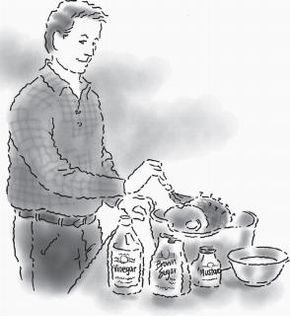When it comes to cooking, vinegar has more jobs to do than just appearing as an ingredient in recipes. It can perform miraculous tricks for improving flavor, preserving food, filling in for missing ingredients, and even making food look better. This ingredient can prevent spoilage and salvage the occasional cooking disaster. In fact, if you add a drop here and there during the preparation process, vinegar may change the whole personality of certain foods. In this article, we'll show you lots of ways to incorporate vinegar in the kitchen.
The Basics
: When getting to the bottom of a ketchup bottle, add a little vinegar and swish it around to make the ketchup stretch further. This technique will work for other condiments as well.
Advertisement
Eggs: You can still hard-boil a cracked egg by adding 1 tablespoon of vinegar to the boiling water. The vinegar will prevent the egg white from running out.
: Add a tablespoon or more of vinegar when frying or boiling fish to reduce fishy tastes and smells and to keep the meat soft.
Give canned shrimp and fish a freshly caught taste by covering it in sherry and adding 2 tablespoons vinegar. Soak for 15 minutes, then prepare as desired.
To keep fish white, soak for 20 minutes in a mixture of 1 quart water and 2 tablespoons vinegar.
: When cooking fruit on the stovetop, add a spoonful of vinegar to improve the flavor.
When making mashed potatoes, add 1 tablespoon of vinegar once you've used enough milk. This will help keep potatoes white. Whip them to desired consistency.
In a tomato sauce or a tomato-based soup, add 1 or 2 tablespoons of vinegar just before completing the cooking process. Flavors will be enhanced.
Meat: Add zip to a pound of hamburger by adding garlic wine vinegar and 1/2 teaspoon mustard. Work these ingredients into meat before making into patties.
Improve the flavor of boiled ham by adding 1 tablespoon vinegar to the cooking water.
The acid content and tangy flavor of vinegar makes it an excellent ingredient in a marinade for meat, poultry, fish, or vegetables. Vinegar can also tenderize tough cuts of meat.
Baking Tips
Vinegar comes in really handy when it's time to do some baking.
: Use vinegar to determine if old baking soda is still good enough for baking. Pour 2 tablespoons vinegar in a small dish, and add 1 teaspoon baking soda. Good baking soda should make the vinegar froth significantly.
: Make the crust of homemade bread a nice, golden brown by removing it from the oven shortly before baking time is complete and brushing it with vinegar. Return to oven to finish baking.
You can help homemade bread rise by adding 1 tablespoon of vinegar for every 21/2 cups flour in the recipe. Reduce other liquids in recipe proportionately.
: Make a fluffier meringue that is also more stable by adding vinegar to egg whites before beating. For every 3 egg whites in recipe, add 1/2 teaspoon of vinegar.
: Reduce the overly sweet flavor in fruit pies or other desserts by adding a teaspoon of vinegar.
As you'll see in the next section, vinegar has other uses in the kitchen -- like as a food preservative or a recipe substitute.
Advertisement
